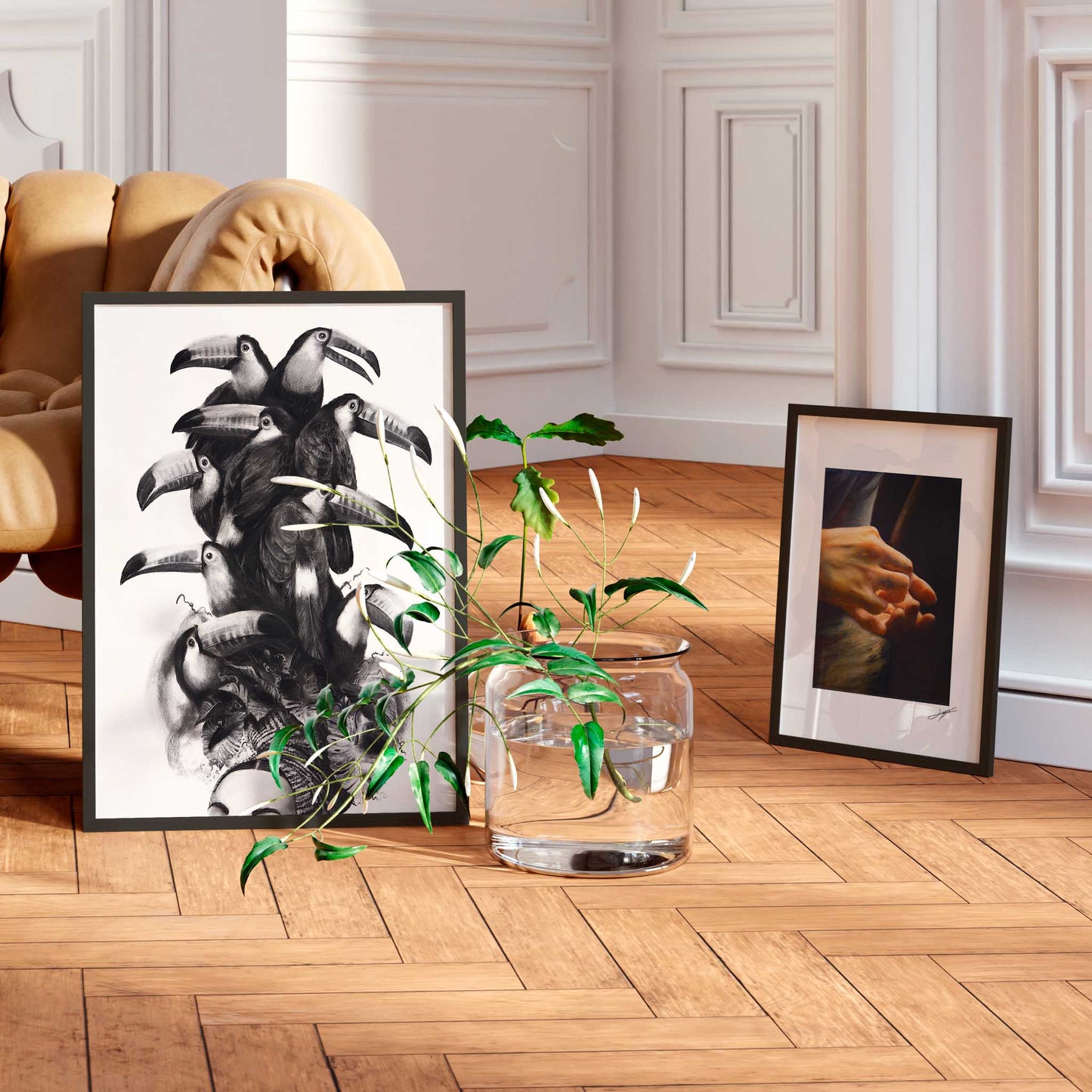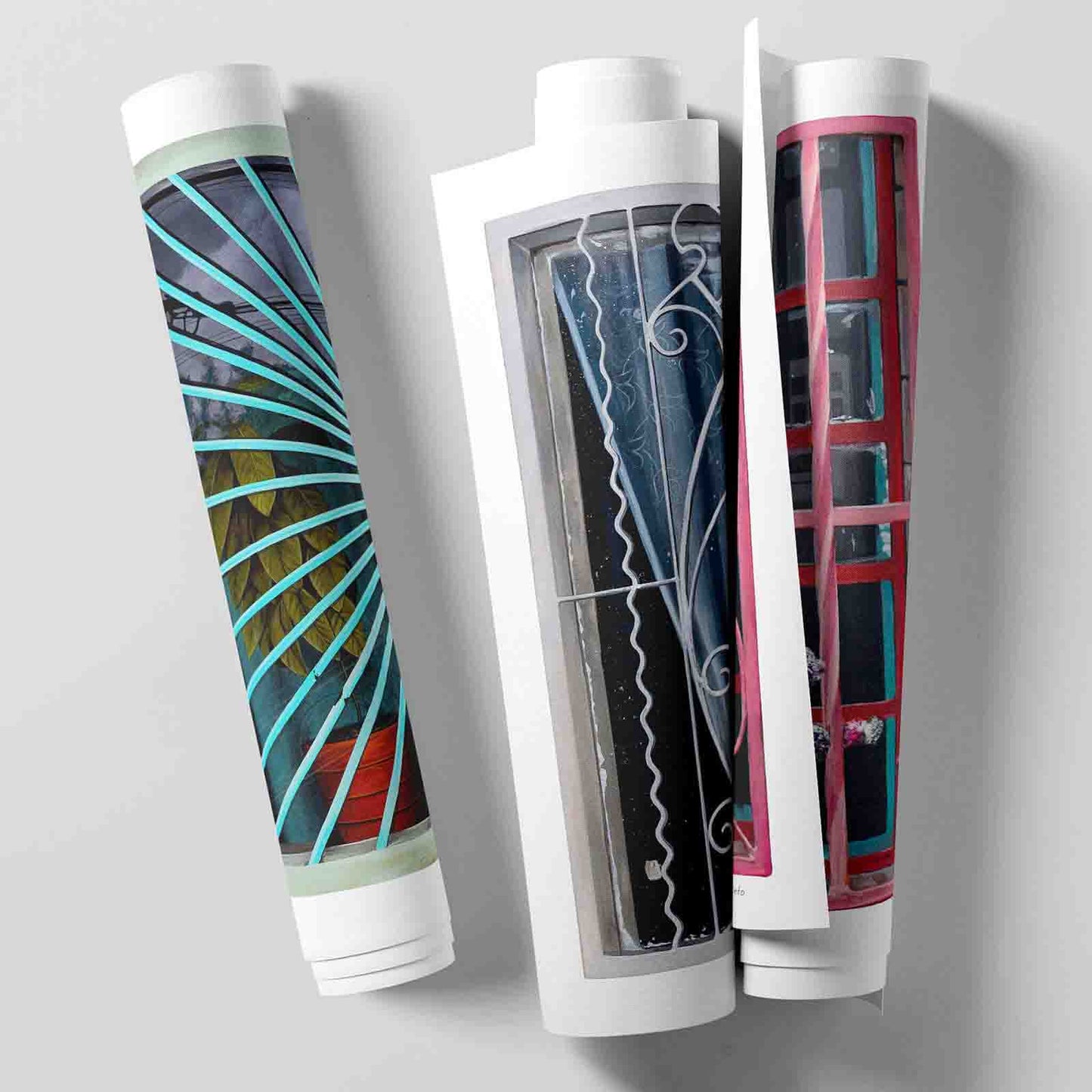Shop limited edition prints running low on stock. Once they're gone, they're gone!
Once you’ve chosen the perfect art print for your home, one that speaks to you, makes you smile or brings a burst of Latin American colour and culture into your space, the next big decision is how to frame it. And surprisingly, one of the most important choices isn’t the wooden frame itself, but what goes inside it.
The transparent layer that sits over your artwork is known as picture frame glazing, and it usually comes in two materials: glass or acrylic. Glazing plays a crucial role in protecting your art prints from dust, UV light, humidity and everyday wear and tear, while also influencing how an artwork will look on your wall.
So, which is better, acrylic or glass glazing? The answer depends on your space, lifestyle and artwork type. Let’s explore the differences so you can choose the best frame for your art prints with confidence.
What Is Picture Frame Glazing?
Picture frame glazing is the transparent layer that covers and protects your artwork inside the frame. It helps shield art prints, photographs and posters from environmental damage while allowing their colours and details to shine through.
The two most common glazing materials are:
• Glass
• Acrylic (also known as Perspex or Plexiglas)
Both have advantages and drawbacks, and understanding these will help you protect your art while ensuring it looks its very best when on display.
Glass Picture Frames: Pros and Cons
Advantages of Glass Frames
Glass has long been the traditional choice for framing art, and with good reason.
• Durable and stable: Glass doesn’t degrade or warp over time.
• Scratch-resistant: Its hard surface makes it difficult to scratch.
• Easy to clean: Dust and fingerprints can be wiped away with ease.
• Fully recyclable: Glass retains its quality in the recycling process.
Glass frames often feel classic and high-end, making them appealing for smaller artworks or traditional interiors.
Disadvantages of Glass Frames
Despite its strengths, glass does come with some notable drawbacks.
• Fragile: Glass can break during shipping or installation.
• Shatters when broken: This can damage the artwork and pose a safety risk.
• Green tint: Standard glass slightly dulls colours, reducing clarity.
• Condensation risk: Moisture can build up behind the glass.
• Heavy: Glass is dense, making large framed artworks harder to hang and more expensive to ship.
Acrylic Picture Frames: Pros and Cons
Acrylic glazing has become increasingly popular in recent years, especially for contemporary art prints and modern interiors. Technological developments have increased its quality and the proliferation of affordable prints has opened a new market of collectors looking for alternative framing methods.
Advantages of Acrylic Frames
• Shatter-resistant: Acrylic is extremely hard to break, making it safe to use.
• Lightweight: Easier to ship, handle and hang on the wall.
• Optically clear: No green tint, so colours appear brighter and truer.
• UV resistant: Offers natural protection against fading.
• Condensation resistant: Helps protect artwork from moisture damage.
• Lower environmental impact in production: Uses less energy than glass during manufacturing.
For vibrant art prints, acrylic allows colours to really pop.
Disadvantages of Acrylic Frames
• More prone to scratches than glass if cleaned incorrectly.
• Recycling options can be limited depending on local facilities.
• Surface static can affect original pastel artworks (not an issue for prints).
• May warp under extreme heat or humidity.
With proper care, these disadvantages can be easily managed in everyday home use.
Key Factors to Consider When Choosing Acrylic or Glass
Beyond the materials themselves, several external factors should influence your decision.
Lighting: Will Your Art Be Exposed to UV Light?
UV light, both natural and artificial, can cause artworks to fade over time.
• Acrylic glazing naturally blocks some UV light and can be upgraded to conservation acrylic for even greater protection.
• Standard glass offers no UV protection. Conservation glass does, but it’s expensive and only used for museum-quality framing.
No matter what glazing you choose, avoid hanging art in direct sunlight. At Studio Parga, our art prints are created using archival paper and lightfast pigment inks, designed to last up to 100 years in proper storage or display conditions.
Location: Where Will the Artwork Hang?
Think about how much activity happens your artwork.
• High-traffic areas (hallways, staircases): Acrylic is safer due to its shatter resistance.
• Above beds or seating areas: Acrylic is strongly recommended for safety.
• Low-risk areas (above sideboards or dressers): Either glass or acrylic works well.
If there’s any chance the artwork could be knocked, acrylic offers peace of mind.
Size: Are Acrylic Frames Better for Large Art Prints?
In most cases, yes.
Large artworks framed with glass can become very heavy, requiring:
• Stronger wall fixings
• Larger frame mouldings
• Extra reinforcement
Acrylic’s lightweight nature makes it ideal for large statement art prints, allowing you to enjoy bold designs without worrying about weight or wall safety.
Sustainability: Glass vs Acrylic Frames
• Glass is made from natural materials and is fully recyclable, but it is energy-intensive to produce and transport.
• Acrylic is manmade from non-renewable resources but requires less energy to produce and is lighter to ship, therefore reducing emissions.
From a full lifecycle perspective, acrylic is often the more environmentally responsible option for framed art prints.
Cost: Which Is More Affordable?
Cost depends on your needs.
• Standard glass is affordable but lacks UV protection.
• Conservation glass is expensive.
• Standard acrylic offers UV protection at a lower cost.
• Conservation acrylic balances protection and price better than conservation glass.
If you’re making a long-term investment in art, higher-quality glazing is worth considering. For prints you may want to rotate from time to time, standard acrylic is a practical and cost-effective choice.
Conclusion: Acrylic or Glass, Which Should You Choose?
Glass frames offer a traditional, durable finish and work well for small artworks in low-risk environments. However, their weight, fragility and colour tint can be limiting. For most modern interiors and art prints, acrylic glazing is the superior choice. It’s lightweight, shatter-resistant, clearer, safer and better suited to larger artworks. These benefits make acrylic a favourite among galleries, artists and collectors alike.
Why We Use Acrylic at Studio Parga
At Studio Parga, we frame all of our prints using high-quality cast acrylic glazing. Combined with archival cotton rag paper and lightfast pigment inks, this ensures your art prints are protected from UV light, condensation, and dust, so they can be enjoyed for an entire lifetime.
Explore our curated collection of art prints by Latin American artists and experience the difference for yourself.
Frequently Asked Questions: Acrylic vs Glass Frames
Is acrylic better than glass for framing art prints?
For most art prints, acrylic is better than glass because it’s lighter, safer, clearer and offers UV protection, helping to preserve colours over time.
Do acrylic frames scratch easily?
Acrylic can scratch more easily than glass, but careful cleaning with a soft cloth prevents damage. Minor scratches can be polished out.
Are acrylic frames suitable for large artworks?
Yes, acrylic frames are ideal for large art prints because they are lightweight and don’t require heavy-duty wall fixings.
Does glass make artwork look greener?
Standard glass has a slight green tint, which can dull colours. Acrylic is optically clear and shows artwork colours more accurately.
Which is more environmentally friendly: acrylic or glass?
Both can be recycled, but acrylic generally requires less energy to produce and ship, making it a more sustainable option in many cases.
Discover beautifully framed art prints by Latin American artists and find the perfect piece for your home today.




































